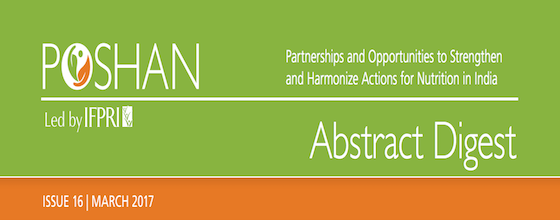This issue of the Abstract Digest features our new Policy Note, summarizing costs of delivering a set of essential nutrition interventions at scale in India. We also bring to you the new WHO guidelines for improving the quality of maternal and newborn health and infant and young child feeding (IYCF) practices, two Alive & Thrive studies on IYCF, work on the performance of anganwadis under the Integrated Child Development Services (ICDS), models for the management of severe acute malnutrition (SAM), and studies on ICDS and health programs that deliver the essential nutrition interventions in India. Here are some more highlights:
- Frongillo and colleagues (2016) find that an intensive intervention involving a package of intensive interpersonal counseling on infant and young child feeding (IYCF), mass media campaign, and community mobilization, implemented at scale to improve IYCF practices, advanced language and gross motor development of Bangladeshi children.
- An intense interpersonal counseling intervention, using principles of social franchising within a government health system, combined with mass media and community mobilization, improved dietary diversity among children in Vietnam (Rawat et al. 2017).
- In a systematic review of 52 studies, Welch et al. (2017) find that mass deworming for soil-transmitted helminths in low-to middle-income countries has little to no effect on the height, cognition and school attendance, and might only have a slight effect on weight.
- In a cluster-randomized controlled trial, Mehta and colleagues (2017) find that daily consumption of an iron-supplement bar for 90 days reduces anemia prevalence among 18–35-year-old non-pregnant women in Mumbai. Prentice and colleagues (2016) argue that although non-physiological amounts of supplemental iron increase the risk of bacterial and protozoal infections, and that the use of lower quantities of iron provided within a food matrix might be safer.
- In a first randomized trial comparing options for a home-based management of uncomplicated severe acute malnutrition (SAM), Bhandari et al. (2016) find that locally prepared ready-to-use therapeutic food (RUTF-L) is more efficacious than energy-dense home-prepared foods (A-HPF). Thapa et al. (2017) find a locally produced ready-to-use therapeutic food called Nutreal to be more effective than defined food in the management of SAM among children under five years of age.
- Using data from the Rapid Survey of Children on Children, Maity (2016) constructed four indices, the knowledge index, infrastructure index, service index, and awareness index to characterize the anganwadi center services and their awareness across India.
- Using qualitative methods, Gupta et al. (2017) find that in Haryana the National Rural Health Mission (NRHM) improved health infrastructure, accessibility and affordability of maternal and child health services.
- In a cluster randomized controlled trial, Singh and Mitra (2017) test the effectiveness of various performance contracts and find high absolute incentives to workers, combined with nutritional information to mothers, improve severe malnutrition among 3–6-year-old children in urban slums of Kolkata.
- McDougal et al. (2017) discuss how a health system training and community outreach intervention called Ananya, improved reproductive, maternal and newborn health coverage in Bihar.
- Kim and colleagues (2017) argue that congruent or shared priorities and regularity of actions between the Integrated Child Development Services (ICDS) and National Rural Health Mission (NRHM) is crucial along with clear roles and leadership and accountability for improving the delivery and utilization of interventions for maternal and child nutrition in India.
- Lodenstein et al. (2016) reviewed 37 social accountability initiatives in 15 countries and find that health provider receptivity to citizen’s demands is mediated by health providers’ perceptions of the legitimacy of the citizen groups and the support that such citizen groups provide to health providers as well.
- Fitzpatrick and Tumlinson (2017) discuss strategies for optimal implementation of mystery client approach for measuring quality of care in low- and middle-income countries.



